Customizing Emails
Customizing your store email templates allows you to tailor their content and appearance to fit your brand, adding to the customer experience. The BigCommerce control panel includes settings to edit text, add custom code, and enable or disable specific email templates.
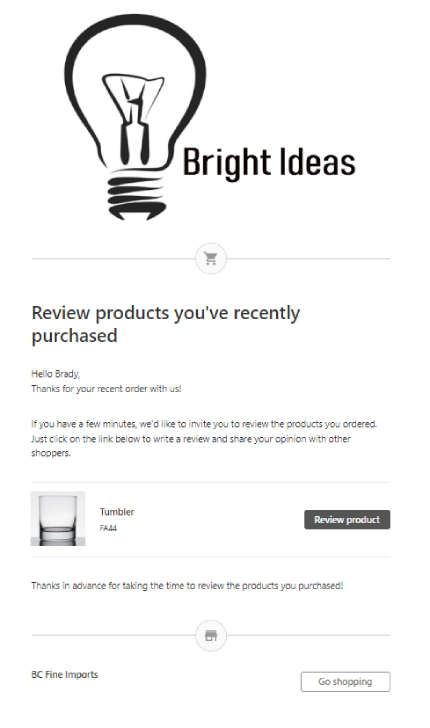
Requirements
In order to view and edit store email templates, you must have the following permissions enabled in your user account:
- Manage Channels
- Store Design
How It Works
Your store uses the email templates in Marketing › Transactional Emails to automatically send emails when shoppers perform certain actions in your store, such as signing up for a customer account or placing an order. All email templates are enabled in your store by default, but you can disable a template at any time to prevent customers from receiving an email when they perform the corresponding action.
Using a third-party app to manage customer emails? You may want to disable some or all of your store’s built-in email templates to prevent your customers from receiving multiple emails.
While editing your emails, you can customize the global template, or create unique templates for each of your native or headless storefronts. Email template customization settings are broken up into the following tabs:
- Phrases — specify the text in the email’s subject and body
- Code — customize the HTML and CSS coding of the email template to fine-tune its appearance and add content like images, links, and Buy Buttons
- Preview — view an example of the email template before going live with your changes
Email templates use variables to automatically supply relevant information, such as the customer’s name or their order number. Some variables, like store name or customer email address, can be used in all email templates, while others, like order status and shipping method, are only supported in particular templates.

If you wish to restore the phrases and code to their original values while editing a template, select Reset to system default from the Action menu (⋯).

Email Templates
The following email templates are available for editing:
- Abandoned Cart* — sent when a customer abandons a shopping cart
- Account Settings Edited — sent when a customer makes a change to their account email address or password
- Password Reset — sent when a password reset has been requested or forced
- Order Status Update — sent when an order's status is changed
- Order Email — sent when a customer places an order
- Guest Account Created — sent when a customer checks out as a guest and has an account automatically created for them
- Gift Certificate Recipient — sent to the recipient of a gift certificate
- Sign-in Link Request — sent when an existing customer requests to use passwordless login while checking out
- Order Notification — sent when a message is added to an order
- Product Review Request — sent after an order has been placed, asking a customer to review the items they purchased
- Return Requested — sent when a customer submits a return request
- Account Created — sent when a customer creates a storefront account
- Return Status Change — sent when a customer's return request status is updated in the control panel
- Order ready for pickup — sent when an order placed using Buy Online, Pick up in Store APIs is marked as ready for pickup in the control panel
*The content and settings for Abandoned Cart emails are managed in Marketing › Abandoned Cart Emails. Any changes made to the content and settings are referenced in the Abandoned Cart email template.
Managing Email Templates
To view your email templates, go to Marketing › Transactional Emails in the control panel. This page lists your store’s default global templates, along with a label to show if they are currently enabled or disabled.

Localized Store Experiences: This feature is available for all of our supported languages. For more information on the default language store setting, see Store Profile Settings.
If you have more than one storefront, you can choose to have your storefront use your store’s default global templates and settings, or you can enable and customize templates individually per storefront. Use the dropdown list at the top of the page to switch between managing global templates and individual storefront templates.
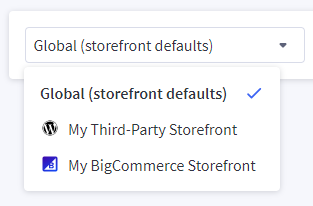
Click the Action menu (⋯) next to a template, then select select Edit Template from the dropdown to edit its phrases or code. You can also Disable or Enable a template from the dropdown.
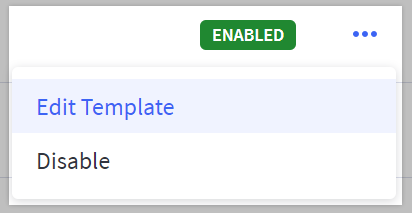
To enable or disable a template while editing it, click the Action menu (⋯) at the top of the page and select Enable or Disable.

How do I disable the Password Reset and Sign-in Link Request email templates? Please contact our support team to enable this functionality.
Editing Template Phrases
Under the Phrases tab, you can customize the text used in the template. The Phrase name is an identifier used in the template code that outputs a string of text in the resulting email, called the Phrase value. The phrase name is not visible to the shopper.

You can change the Phrase name and Phrase value of existing phrases, or you can delete existing phrases by clicking the Action menu (⋯) next to the phrase and selecting Delete phrase. You can also create new phrases in a template by clicking the + Add new button at the bottom of the Phrases tab.

For example, you can add a phrase named "contact" to direct customers to contact you at a specific email address. In the phrase value, you can enter a phrase like "Contact us at info@mystore.com". It is also possible to add HTML in the phrase value if you want to create a clickable link like "<a href="mailto:info@mystore.com">info@mystore.com</a>".

Editing Template Code
Under the Code tab, the Subject line and Content of each template can be customized. The subject has a maximum character limit of 255. Select variables are allowed, enabling you to show personalized information. Some variables can be used on their own in a template, while other variables require additional formatting to show specific information. For example, the store name can be used on its own, but listing the products contained in an order requires additional formatting.

Editing code? We recommend saving a backup copy of your template in a plain text editor such as Notepad or TextEdit. You can also restore the default version of an email's global template with the instructions below.
The body of the template is customized by editing its underlying HTML and Handlebars code. It is divided between CSS styling at the top and HTML content at the bottom. We recommend making edits by copying the template code into a text editor and pasting the edited version back into the Content box.
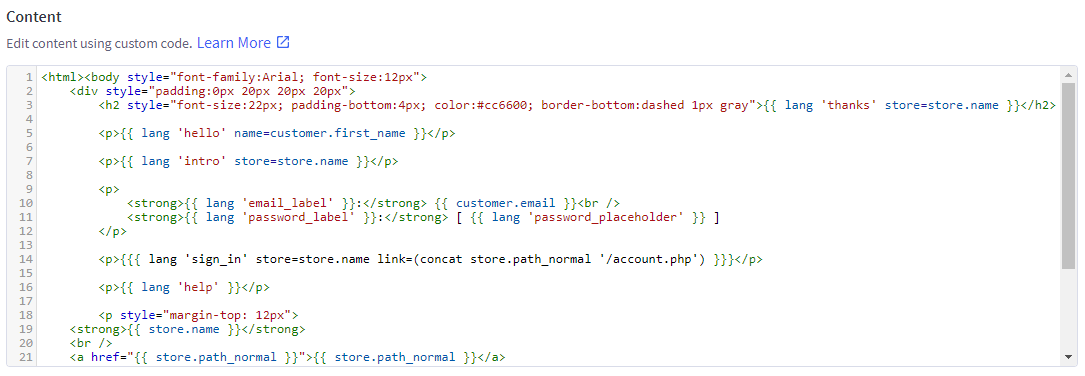
One example of what you can do in the Code tab is removing the "Powered by BigCommerce" text at the bottom of an email and replacing it with a phrase. To do this, locate the text in the code and delete it, leaving the paragraph tags. You can then add in a phrase bracket in its place in the format of {{{ lang 'your_phrase_name' }}}.
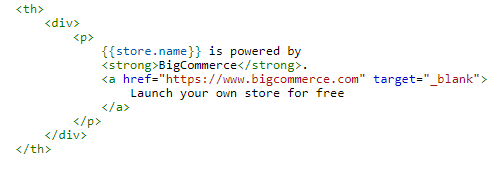
For more examples of how you can customize your email template code, see our developer documentation.
Previewing Your Changes
Under the Preview tab, you can see a sample of the resulting email the template will produce. In the example of replacing the "Powered by BigCommerce" text with a phrase, you can see how the phrase will appear in the email, and go back to the Phrases or Code tabs to make further changes if necessary.
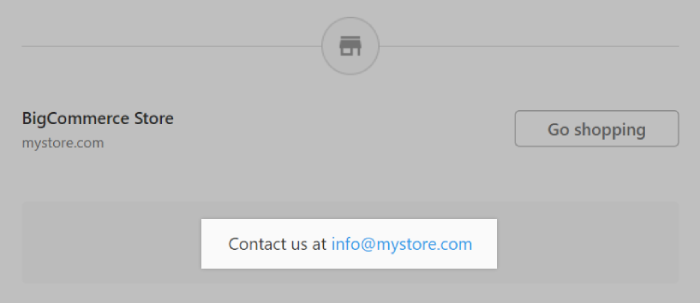
When previewing an email template, it will display example content, such as order details in the Order Status Update template, or a product review link in the Product Review Request template. This is replaced with information relevant to your customer when they receive an email.
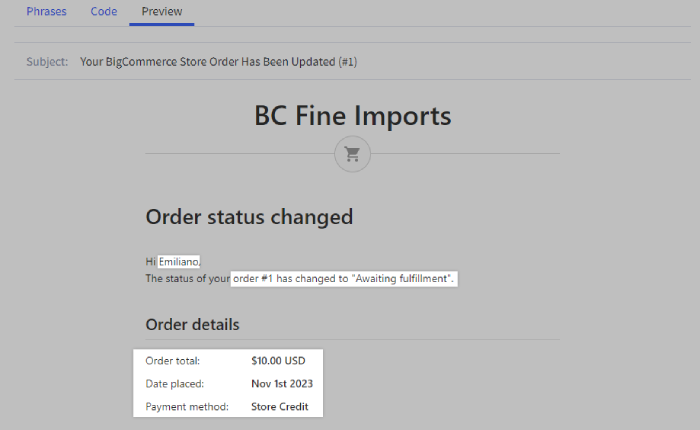
Click Save when you’re done making changes.
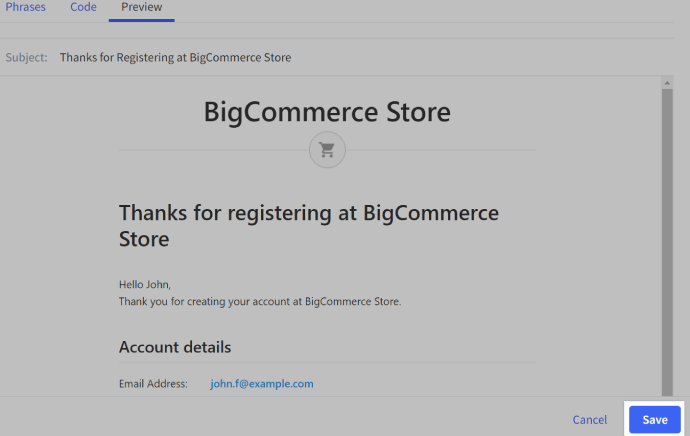
You can also send a copy of a template’s resulting email to the inbox of your user account email address by clicking Send test email.

Table of Global Variables
Below is a table of global variables that can be used in email templates. For a list of variables that can be used in specific templates, see our developer documentation.
| Variable | Corresponds to: | Output example |
|---|---|---|
| store.name | your store's name | "Thanks for Registering at My BC Store" |
| store.domain_name | your store's domain name | "Your mybcstore.com account details have changed" |
| store.logo.title | your store's logo text (used as alt text for your logo image) | My BC Store |
| store.logo.url | your store's logo image URL | https://cdn11.bigcommerce.com/s-xyz123/product_images/storelogo.jpg |
| store.ssl_path | your stores HTTPS URL | "Your https://mybcstore.com account details have changed" |
| store.cdn_path | your store's content delivery network path URL | https://cdn11.bigcommerce.com/s-xyz123 |
| store.image_directory | the image directory URL tail in your store's CDN path | {{ store.cdn_path }}/{{ store.image_directory }} = https://cdn11.bigcommerce.com/s-xyz123/product_images |
| store.path_normal | your store's HTTPS URL (used as link at the bottom of some emails) |
"My BC Store https://mybcstore.com" |
| store.path | your store's HTTPS URL (used as link in the logo and "go shopping" button) | https://mybcstore.com |
| store.address | your store's physical address |
"My BC Store 110 Inner Campus Drive Austin, TX 78750 United States of America" |
| store.language.code | the language file used by your store's theme | If your theme is using en.json, then {{ store.language.code }} will be en |
| store.language.direction | the direction that the text in your store is read | If the text in your store is read left-to-right, then {{ store.language.directory }} will be ltr |
| customer.first_name | The customer's first name | "Hello, John," |
| customer.full_name | The customer's full name | "Hello, John Smith," |
| customer.email | The customer's email address | "Email Address: john.s@example.com" |
| customer.group.name | The name of the customer group associated with the customer’s storefront account | Wholesale |
| misc.year | The current year | "© 2023 My BC Store" |
FAQ
Is there a native/built-in way to add your own tracking links for emails sent by BigCommerce?
No, you must supply the carrier code and tracking number. BigCommerce uses that information to generate the tracking link (or just the carrier name and tracking number if it's not a supported tracking carrier).
If you want to make your own tracking links, it's best to look outside of BigCommerce to send those notification emails. For example, this is ShipStation's documentation on Customer Notification Settings.
Can I change the sending email address for my store’s emails?
Yes, your store’s email address is located in Settings › Store profile. See Store Profile Settings for additional information about changing your store’s email address.
Using Multi-Storefront? Each storefront's email address is located in the storefront-specific Contact information settings within Channel Manager. See Single-Storefront vs. Multi-Storefront for more information.
Why are my emails showing raw HTML instead of the phrases or variables I added to the template?
A custom variable or phrase added to the Code section of your email template can appear as raw HTML if it is contained within two curly brackets instead of three. For example, {{ lang 'yourcustomphrase' }} will display as raw HTML, but {{{ lang 'yourcustomphrase' }}} will properly display your custom phrase.
Can I display product brands in my emails?
Yes. Although brands are not included by default, they can be added as a variable in the following email templates:
- Order Status Update
- Order Email
- Return Requested
- Return Status Change
- Order ready for pickup
 © Copyright 2003 - 2024 BigCommerce Pty. Ltd. Shopping Cart Software
© Copyright 2003 - 2024 BigCommerce Pty. Ltd. Shopping Cart Software